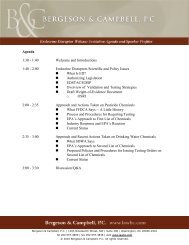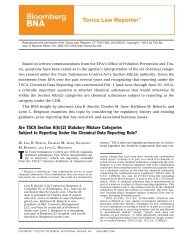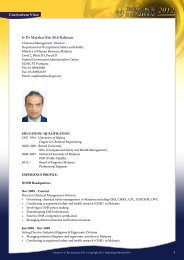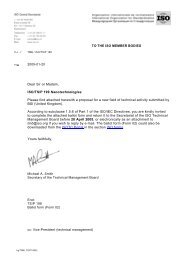TSCA Section 8(b) - Bergeson & Campbell, P.C.
TSCA Section 8(b) - Bergeson & Campbell, P.C.
TSCA Section 8(b) - Bergeson & Campbell, P.C.
- No tags were found...
You also want an ePaper? Increase the reach of your titles
YUMPU automatically turns print PDFs into web optimized ePapers that Google loves.
7that are applied to listings of certain mixtures inthe <strong>TSCA</strong> Inventory. 40Appendix D referred to by EPA is its 1995 StatutoryMixtures Policy. None of this language or the policy isincluded in EPA’s final instructions. 41 There does notappear to be a publicly available explanation clarifyingthe reasons for its deletion.A summary of the reporting on the <strong>Section</strong> 8(b)(2)statutory mixture categories which occurred during the2006 IUR reporting based on EPA’s publicly availableIUR database 42 is as follows:s Cement, Portland: 18 entities at 32 productionsites, reported > 1 billion pounds (total);s Cement, Alumina, Chemicals: Four entities at foursites, reported 1 to 10 million pounds;s Glass, Oxide, Chemicals: Seven entities at eightsites reported 50 to 100 million pounds;s Frits, Chemicals: Four entities at five locations reported50 to 100 million pounds;s Steel Manufacture, Chemicals: 47 entities at 87sites reported > 1 billion pounds; ands Ceramic Materials and Wares, Chemicals: 10 entitiesat 18 sites reported > 1 billion pounds.These numbers may reflect an inconsistency in howstatutory mixture categories were reported under the2006 IUR, since certain categories have volumes in themillions and others having volumes in the billions, althoughthese differences may also be explained if certainmanufacturers claimed their data as confidentialbusiness information. In the final CDR rule, EPA statedthat it was replacing the 5-digit NAICS codes with 48 IndustrialSector (IS) codes, and one of the codes is for‘‘Non-metallic Mineral Product Manufacturing (includesclay, glass, cement, concrete, lime, gypsum, andother non-metallic mineral product manufacturing)’’ althoughthere is no discussion of how this IS code relatesto any reporting obligations on statutory mixture categories.43When industry sought clarification in 2007 regardingthe <strong>Section</strong> 8(b)(2) chemical categories and potentialPMN requirements, EPA’s response raised several concernsabout EPA’s current interpretation of its <strong>Section</strong>8(b)(2) Statutory Mixtures Policy. The first EPA letter,dated September 18, 2007, responded to four questionsrelated to the <strong>TSCA</strong> Inventory status for ‘‘Glass, oxide,chemicals’’ and ‘‘Ceramic material and wares, chemicals.’’44 In response to a question asking EPA to ‘‘reaffirmEPA’s longstanding guidance on the use of CAS-40 EPA, Draft Instructions for Reporting for the 2006 PartialUpdating of the <strong>TSCA</strong> Chemical Inventory Database (Nov.2004) at 2-11, available at http://www.regulations.gov bysearching for EPA-HQ-OPPT-2005-0008-0003.41 EPA, Instructions for Reporting for the 2006 Partial Updatingof the <strong>TSCA</strong> Chemical Inventory Database (Nov. 2006),available at www.epa.gov/iur/pubs/2006_inst_tsca_cheminv.pdf.42 EPA, IUR Data for 2006, available at http://www.epa.gov/iur/tools/data/2006archivedata.html.43 76 Fed. Reg. 50,827.44 Letter from Tracy C. Williamson, Ph.D., Chief, IndustrialChemistry Branch, EPA, to Greg McCarney, 3M Toxicologyand Regulatory Services (Sept. 18, 2007) (2007 EPA Letter).RNs that were established for the six categories,’’ EPAresponded in part:Consistent with this regulatory text [at <strong>Section</strong>710.4(c)(2) and its Note], EPA did not intend forthese six chemical descriptions and CASRNs,which the Agency sometimes refers to as ‘‘statutorymixtures,’’ to be used to establish chemicalnomenclature and determine Inventory status foractual chemical substances manufactured or importedfor commercial purposes that may in a genericsense be thought of or described as eitherPortland cement, alumina cement, glass, frits,steel, or ceramics. The CASRNs for these ‘‘statutorymixtures’’ were included in the Initial Inventoryfor the purpose of defining the scope of thesevery broad categories of substances, with the expectationthat particular substances or mixturecomponents that fall within one of these categoriesof materials and that are intended to be commerciallymanufactured would be subject to <strong>TSCA</strong>reporting if they were not already explicitly listedin the Inventory. 45In response to another question regarding EPA’sview whether manufacturers and importers of chemicalmaterials covered by the category descriptions shouldobtain unique CASRNs, EPA responded in the letter asfollows:Regarding substances that may fit within the definitionsof the six ‘‘statutory mixture’’ categories,specific chemical identifications that represent reactionproducts instead of starting materialsshould be used for <strong>TSCA</strong> purposes whenever themanufacture of the substances involves newchemical bond formation. In these types of materials,the new bonding may yield crystalline orsemi-crystalline matrices. It is the specific identityof the chemical reaction product composition thatmust be either already included in the Inventoryor reported as a new chemical.For example, with a ceramic type of material, if aparticular chemical substance is to be manufacturedas a result of a high temperature calcinationprocess that causes new bond formation, the specificchemical identity of that chemical productneeds to be included in the Inventory beforemanufacture may commence for a non-exemptcommercial purpose. Such a chemical productmust be either listed in the Inventory or reportedin a <strong>TSCA</strong> <strong>Section</strong> 5 new chemical notice accordingto its synthesized chemical composition. It isnot considered covered for <strong>TSCA</strong> purposes by the‘‘statutory mixture’’ category ‘‘Ceramic materialsand wares, chemicals’’ (CASRN 66402-68-4).On the other hand, if a product associated withone of these categories does not involve intendedchemical reactions, such that no chemical bondsform during its manufacture, the product compositionis considered a mixture and identified bythe starting materials charged in the manufactureof the material.It has always been <strong>TSCA</strong> Inventory policy to listsubstances as specifically as possible. For materi-45 Id. at 2.DAILY ENVIRONMENT REPORT ISSN 1060-2976 BNA 1-26-12







